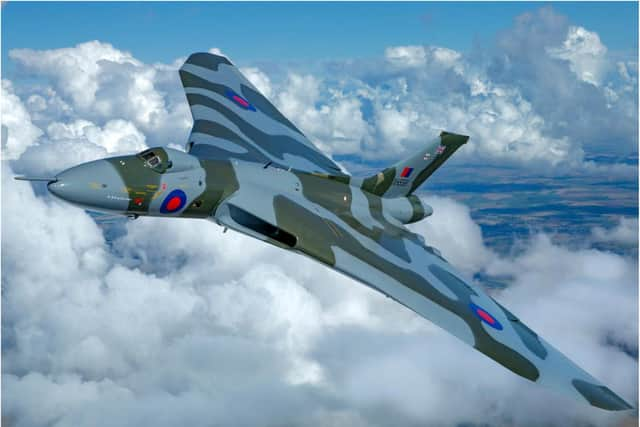Doncaster's iconic Vulcan bomber kept ticking over in lockdown
and live on Freeview channel 276
Chief engineer Kevin 'Taff' Stone has spent the better part of the past three years tasked with maintaining the Vulcan XH558 - dubbed the Spirit of Great Britain.
Each day he lovingly ignites the engine to reveal its thunderous throttle and carefully washes its windows and windscreens.
Advertisement
Hide AdAdvertisement
Hide AdThe Vulcan bomber played a crucial role during the Cold War, and the last one to take to the skies is keeping the story alive for future generations.


When Vulcan bomber XH558 took to the skies for the first time from Woodford Aerodrome, Cheshire, Harold Macmillan was Prime Minister, Yuri Gagarin had yet to become the first man in space and no one had heard of The Beatles.
But on the year of the aircraft’s 60th anniversary a team of hard-working engineers have kept the engine rolling - and remarkably the jet can still soar over 60,000 feet into the sky, although it has not flown for several years.
Taff said: "This aircraft is a Vulcan Mark B2 and it was actually the first B2 into military service back in 1960.
Advertisement
Hide AdAdvertisement
Hide Ad"It stayed in the services until the late eighties, and then it was restored to flight back in 2007 and flew for eight or nine years then on the civil register.
"And now it's still at Doncaster airport doing ground runs and taxi runs and showing the public round.
"What we're doing today is part of our anti-deterioration checks.
"We're just coming down giving the aircraft a once over. Make sure everything's OK and fire up all the systems. Make sure they all work.
Advertisement
Hide AdAdvertisement
Hide Ad"With the lockdown that we have at the minute, your car's been sat on the drive for a couple of weeks.
"So you just go over, turn the engine over, make sure everything's still working.
"And we're doing the same with the aircraft, making sure the aircraft is staying in as serviceable a condition as possible by checking it, looking for any leaks, cleaning things up and then functioning all the systems - just make sure they're still working.”
Though it hasn’t flown in nearly five years, the XH558 is now the last surviving airworthy Vulcan bomber and is based at Doncaster Sheffield Airport which has become a memorial to its era.
Advertisement
Hide AdAdvertisement
Hide AdThe aircraft is looked after by the Vulcan to the Sky Trust and to mark its 60th anniversary, the charity launched a campaign inviting people to immortalise themselves under its wings.
Over 30,000 people have pledged to have their name etched in vinyl and added to a plaque on the underside of the craft, said Dr Robert Pleming, who leads the trust.
The money will contribute to funding for a planned new £4 million centre - the Vulcan Experience - at the airport, which would house the aircraft as well as a green technology hub.
Dr Pleming said: “We not only want to tell her story and that of the Cold War, we also want to show what the airline and aerospace industry are doing to tackle the problem of climate change.
Advertisement
Hide AdAdvertisement
Hide Ad“No one is really telling the story of how the industry is tackling this very significant issue. It is an engineering problem and the solutions lie with engineers and new technologies.
“We’ve all heard about electric cars, well there are also electric aircraft now and there’s a lot to say about the research that’s going on.”
The hope is that this piece of British aviation history could pique the curiosity of youngsters.
He added: “Our mission is not only to talk about the history of the Vulcan and what it did and what it represented at the time, but also to inspire youngsters to get into engineering and technology.
Advertisement
Hide AdAdvertisement
Hide AdThe story of the Vulcan is entwined with British post-war history.
It was designed - along with the Vickers Valiant and the Handley Page Victor - to carry nuclear weapons and act as a deterrent against the Soviet Union, and it was the Vulcan that proved to be the mainstay of the RAF’s bomber fleet during the Sixties.
Its maiden flight came in 1952 and was one of 300 that were built between 1952 and 1965.
The jet was used to collect atmospheric samples after China detonated its first atomic bomb in the Pacific in 1964, an event that sparked widespread alarm in the West.
Advertisement
Hide AdAdvertisement
Hide AdBy the end of the decade several Vulcans, like the one at Doncaster, were converted into maritime radar reconnaissance aircraft.
XH558 was subsequently converted into a tanker aircraft before returning to her original role as a bomber, and then retiring from RAF service in 1993.
However, that wasn’t the end of the story. In 1997, Dr Pleming and a small team started to investigate the possibility of returning it to flight.
Ten years and £7m later, in a triumph of British engineering, the aircraft made its first post-restoration test flight in October 2007.
Advertisement
Hide AdAdvertisement
Hide AdDr Fleming added: “She’s a beautiful shape and incredibly strong because the wings are very thick.
“Our aircraft was the first Vulcan B Mk2 model to go into RAF service and she’s not only the last Vulcan to fly, she’s also the oldest complete Vulcan in existence.”